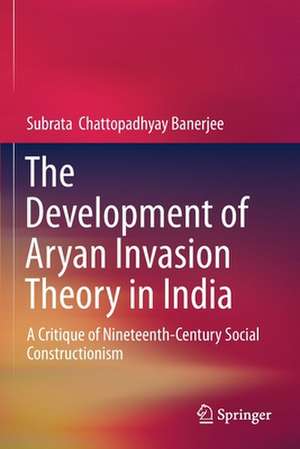The Development of Aryan Invasion Theory in India: A Critique of Nineteenth-Century Social Constructionism
Autor Subrata Chattopadhyay Banerjeeen Limba Engleză Paperback – 14 aug 2020
| Toate formatele și edițiile | Preț | Express |
|---|---|---|
| Paperback (1) | 381.43 lei 6-8 săpt. | |
| Springer Nature Singapore – 14 aug 2020 | 381.43 lei 6-8 săpt. | |
| Hardback (1) | 388.72 lei 6-8 săpt. | |
| Springer Nature Singapore – 28 mai 2019 | 388.72 lei 6-8 săpt. |
Preț: 381.43 lei
Nou
Puncte Express: 572
Preț estimativ în valută:
72.99€ • 75.30$ • 60.91£
72.99€ • 75.30$ • 60.91£
Carte tipărită la comandă
Livrare economică 26 martie-09 aprilie
Preluare comenzi: 021 569.72.76
Specificații
ISBN-13: 9789811377570
ISBN-10: 981137757X
Pagini: 167
Ilustrații: X, 167 p. 1 illus.
Dimensiuni: 155 x 235 mm
Greutate: 0.26 kg
Ediția:1st ed. 2019
Editura: Springer Nature Singapore
Colecția Springer
Locul publicării:Singapore, Singapore
ISBN-10: 981137757X
Pagini: 167
Ilustrații: X, 167 p. 1 illus.
Dimensiuni: 155 x 235 mm
Greutate: 0.26 kg
Ediția:1st ed. 2019
Editura: Springer Nature Singapore
Colecția Springer
Locul publicării:Singapore, Singapore
Cuprins
1 Introduction.- 2 Max Müller’s Beginning of Modern Religious Study and the Silent Formulation of Aryan Invasion Theory.- 2.1 Introduction.- 2.2 Curiosity to Common Past: The Study of Ancient Indian Literature in Europe.- 2.3 Emergence of Max Müller in European Scientific Scene.- 2.4 Max Müller’s First Synthesis: Science Of Language.- 2.5 Max Müller’s Second Synthesis: Science or Religion.- 2.6 Max Müller’s Silent Formulation of Aryan Invasion Theory.- 2.7 Conclusion.- 3 Brahmo Samaj as an Actor in the Dissemination of Aryan Invasion Theory In India.- 3.1 Introduction.- 3.2 A Short Overview of Brahmo Samaj.- 3.3 The Coagulation of Brahmo Samaj: From Conflict To Collaboration With Christian Missionaries.- 3.4 Keshub’s New Synthesis: Making Brahmo Samaj Really Universal.- 3.5 Aryan Invasion Theory and its Contradiction With Christianity.- 3.6 Using the Tools of British Empire: The Politicization of Brahmo Samaj.- 3.7 Summary.- 4 The Role of Christian Missionaries Towards Formulation andSpreading of Aryan Invasion Theory in India.- 4.1 Christianity in 19th Century Europe.- 4.2 Oxford Movement.- 4.3 Colonial Missions.- 4.4 History of Christian Missions In India.- 4.5 Missionary Interest in India: Methods and Outcome.- 4.6 Initial Setback of Missions: Insurmountable Obstacles.- 4.7 Interaction With Indian Social Reformers.- 4.8 Intellectual Conflict Between Missionaries and Social Reformers.- 4.9 Educational Reform Movement: A New Strategy.- 4.10 Christianity and Colonialism in India.- 4.11 Discovery of Aryan Invasion Theory.- 4.12 Müller’s Role in Linguistic Studies: Colonial Ties.- 4.13 Reactions of Christian Missionary Groups to Aryan Myth.- 4.14 Aryan Invasion Theory and the Role of Christian Missions In India.- 4.15 Vedantist Movement in Calcutta After Rammohun.- 4.16 Reactions of Social Reformers: Dayanand Saraswati, Bal Gangadhar Tilak, Jyotirao.- 4.17 Divide and Rule.- 4.18 Adoption By Christian Missionaries: A New Method.- 4.19 Müller’s Communications With Social Reformers in India and the Propagation of Aryan Invasion Theory.- 4.20 Conclusion.- 5 Summary.- 5.1 Extending the Research on Max Müller 179.- 5.2 Future Directions.
Notă biografică
Dr. phil Chattopadhyay Banerjee has completed her doctoral studies from RWTH Aachen University, Germany. She graduated with a Bachelor of Arts from Calcutta University, India and has a Master of Arts with specialisation in Modern History from Rabindra Bharati University, India. Her research interests are broadly in the domains of South-Asian History, Indo-European Socio Religious-Cultural Exchange, Linguistics research and History of Technology in the 19th century. She has given several keynote speeches and invited seminars in these areas. She was affiliated as a Research Fellow in the Wee Kim Wee Centre, Singapore Management University, where she studied the topic of “A Historical Study into the Emergence of Creativity during Cultural Conflict and Integration”. Presently she is pursuing her Postdoctoral research at Nanyang Business School, Singapore, studying the growth of German Economy and their Business Cultural in comparison with Japan.
Textul de pe ultima copertă
This book delves deep into the Social Construction of Theory, comparative epistemology and intellectual history to stress the interrelationship between diverse cultures during the colonial period and bring forth convincing evidence of how the 19th century was shaped. It approaches an interesting relation between the linguistic studies of 19th century’s scientific world and subsequent widespread acceptance of the empirically weak theory of the Aryan invasion. To show entangled history in a globalized world, the book draws on the Aryan Invasion Theory to highlight how different socio-religious parties commonly shape a new theory. It also explores how research is affected by the so-called social construction of theory and comparative epistemology, and deals with scholarly advancement and its relation with contemporary socio-political demands. The most significant conclusion of the book is that academic studies are prone to comparative epistemology, even under the strict scrutiny of the so-called scientific methods.
Caracteristici
Enriches the understanding of the Aryan Invasion Theory which is considered to be empirically weak Enlightens readers with a new viewpoint of the theory which is applicable to the rise of modern scientific practices Questions “how” the theory proliferated instead of “whether” the theory is true
